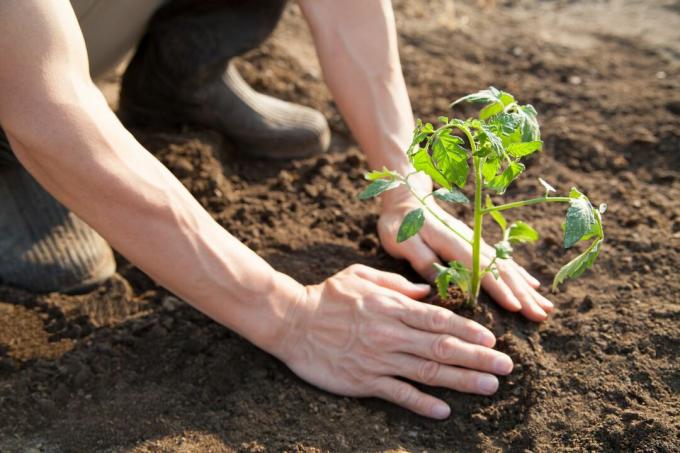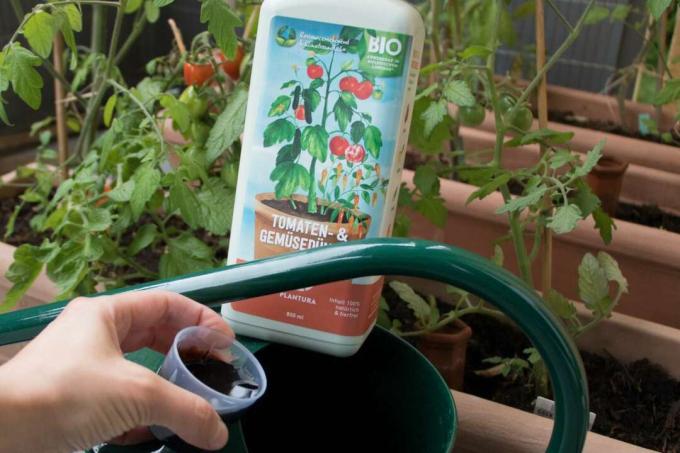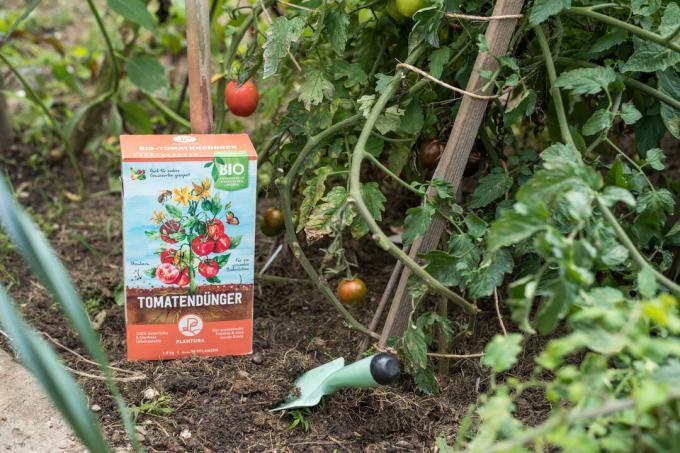When are tomatoes fertilized? How often is tomato fertilization necessary? We reveal everything you need to know about the correct fertilizing of tomatoes.

The tomato grown in almost every kitchen garden (Solanum lycopersicum) has a high nutrient and thus fertilizer requirement. In order to ensure healthy growth and to be able to harvest plenty from your tomato plants, you should therefore fertilize regularly during the growing season. But when exactly should you fertilize your tomatoes? Which fertilizer do you use and how do you use it correctly? We get to the bottom of these questions in this article.
contents
- Why do you have to fertilize tomatoes?
- When and how often should you fertilize tomatoes?
- Properly fertilize tomatoes in the pot
- Fertilize tomatoes in the bed
- Identify nutrient deficiencies in tomatoes
- Tomatoes over-fertilized: what to do?
Why do you have to fertilize tomatoes?
Compared to many other types of vegetables, tomatoes generally have a high nutrient requirement. They are therefore also referred to as heavy feeders. Merely nutrient-rich potting soil is therefore usually not enough for the nutrient-hungry tomatoes and, at the latest, as soon as the fruits form, deficiency symptoms can also be seen. In order to keep tomatoes and other heavy consumers healthy and to stimulate them to produce a high fruit yield, the nightshade family should therefore be given additional fertilizer.

When and how often should you fertilize tomatoes?
How often to fertilize tomatoes depends on the stage of the plant, the available soil and the type of fertilizer. The nutritional needs of tomatoes change depending on the stage of development:
- From sowing to transplanting, the seedlings feed on the supplies from the seeds - during this time they do not need any fertilization.
- Young plants before planting out in May benefit from one or two small doses of fertilizer.
- When planting tomatoes, a good basic supply of nutrients should be mixed into the soil in the form of a slow-release fertilizer.
- During the season until September, you should regularly add important nutrients.
Tomato seedlings initially completely draw on their reserves from the seed. Fertilization is therefore not only superfluous, but rather harms the tender seedlings at this stage, because the many unused nutrients can damage the root system. In return, you even benefit from a nutrient-poor seed soil like our Plantura Organic herbal & seed soil. The low salt content facilitates germination.

After pricking out the tomato seedlings in nutrient-rich potting soil or specially adapted tomato soil - like our Plantura Organic tomato & vegetable soil – the little plants first feed on the soil’s own nutrients. However, it will still be a few weeks before planting out and it is worth fertilizing the young tomato plants. It is sufficient to apply it once or twice. At this stage, we recommend using a gentle, organic liquid fertilizer. The application is simply done via the irrigation water and, thanks to the nitrogen content, ensures good growth and strong green foliage.
Tip: A detailed guide for that Sowing tomatoes as well as for that Pricking out tomatoes can be found in our special articles.
Planting out is the time to do the first proper fertilizing of your tomatoes. Depending on the weather, they can be planted out as early as mid-April to early May in the greenhouse or from mid-May outdoors. When planting, bring the fertilizer directly into the planting hole. Long-term fertilizer, like our primarily organic one Plantura organic tomato fertilizer, release their nutrients only slowly and are therefore gentle on the soil and plant roots.
Properly fertilize tomatoes in the pot
Of course, tomatoes in a pot need just as many nutrients as their colleagues in the bed, but they have a significantly smaller volume of soil at their disposal. The roots therefore only have a limited opportunity to spread out in the pot and tap into nutrients. For this reason, they usually have to be fertilized more frequently. When planting, a long-term fertilizer should be mixed into the soil to provide the plant with nutrients in the first few weeks. The incorporation of granules later becomes difficult in the pot, which is why organic liquid fertilizers for tomatoes are an ideal alternative. Our Plantura Organic Tomato & Vegetable Fertilizer can be easily applied over the irrigation water. Fertilize from June, i.e. as soon as flowering and fruiting begins, about once a week with organic liquid fertilizer. 15 to 25 ml of fertilizer are added to 5 liters of irrigation water, mixed and then poured.
Fertilizing tomatoes in the pot - the right time:
- To plant the tomatoes, mix slow-release fertilizer into the potting soil.
- From June you should fertilize with organic liquid fertilizer about once a week over the irrigation water.

Fertilize tomatoes in the bed
In the bed, it is a little easier to supply the tomatoes with nutrients. Mature compost or a predominantly organic tomato fertilizer with a long-term effect - like ours - is used directly when planting out Plantura organic tomato fertilizer – mixed into the excavated soil of the planting hole. 120 to 230 grams of our high-potassium granular fertilizer will feed a tomato plant for a whole season. Between 70 and 150 grams are given directly at planting and the remaining 50 to 80 grams after about two months. To do this, the recommended amount is raked into the surface of the soil - but be careful not to damage the roots of the tomatoes. A 1.5 kg litter pack of our granular fertilizer is sufficient for up to 20 tomato plants, depending on the variety.
In addition to a gentle release of nutrients, predominantly organic long-term fertilizers also have positive effects on soil life and act in contrast to most mineral fertilizers environmentally friendly. Mineral based fertilizers such as blue grain and Co. only provide a short but strong nutrient boost. However, in the long term they are not enough for the heavily consuming tomatoes and can strongly stimulate vegetative growth, which may increase susceptibility to disease. With heavy watering or a heavy rain, the water-soluble minerals are quickly washed out and end up in the groundwater instead of in the plant.

Fertilize tomatoes in the bed - the right time:
- The first fertilization should take place when the tomato plants are planted out, by mixing slow-release fertilizer into the planting hole.
- After about 2 months, the fertilization with the long-term fertilizer should be repeated again.
Tip: vegetable broths, like nettle manure, can have a supporting and plant-strengthening effect thanks to their numerous ingredients.
Identify nutrient deficiencies in tomatoes
Nutrient deficiency in tomatoes usually shows itself in the form of leaf discoloration:
- nitrogen (N): If there is a lack of nitrogen, the older leaves first turn yellow, later turn brown and finally fall off. The young, upper leaves are still green for a long time until the shortage gets the better of them. In general, the plant looks rather pale green, grows poorly and hardly forms any new shoots.
- Potassium (K): Potassium deficiency, on the other hand, manifests itself in the form of brown and dry tissue on the leaf edges. Eventually, the desiccation migrates between the leaf veins while the veins remain green. Whole leaves can dry up without it being due to a lack of water.
- Phosphorus (P): If there is a lack of phosphorus, the tomato plant reacts with a purple leaf coloration of the older leaves, first on the underside of the leaf, later globally.
- Calcium (Ca): Another important nutrient is calcium (Ca), as it is responsible for the stability of the cell walls. Typically, calcium deficiency is shown by the dreaded blossom end rot. Lime with a high calcium content at planting and two months later for fruit formation can be used tomato damage impede.

Tomatoes over-fertilized: what to do?
Over-fertilization of tomatoes is caused by excessive nutrient additions, mostly from fast-dissolving mineral fertilizers. Depending on the nutrient element, over-fertilized tomatoes react with burnt roots, overshooting leaves and leaves Shoot growth, growth disorders or stunted growth, which lead to increased disease sensitivity can. The fruit quality also quickly suffers from over-fertilization. In an acute case, the only thing that often helps is to transplant the plant into fresh soil. Excess nitrogen can also be bound in the long term with mulch materials that are difficult to decompose, such as wood chips or straw.
As a preventive measure, you should have the site carry out a soil analysis to determine the nutrient levels. Site-adapted fertilization is essential for outdoor and greenhouse tomatoes, also to maintain long-term soil health and fertility. the soil pH also provides information on how to fertilize. When fertilizing tomatoes in tubs and outdoors, you should never exceed the fertilizer recommendations given.
In addition to fertilizing, there are other care measures from which tomatoes benefit immensely during growth. In our article on Tomato watering and mulching learn more about it.



